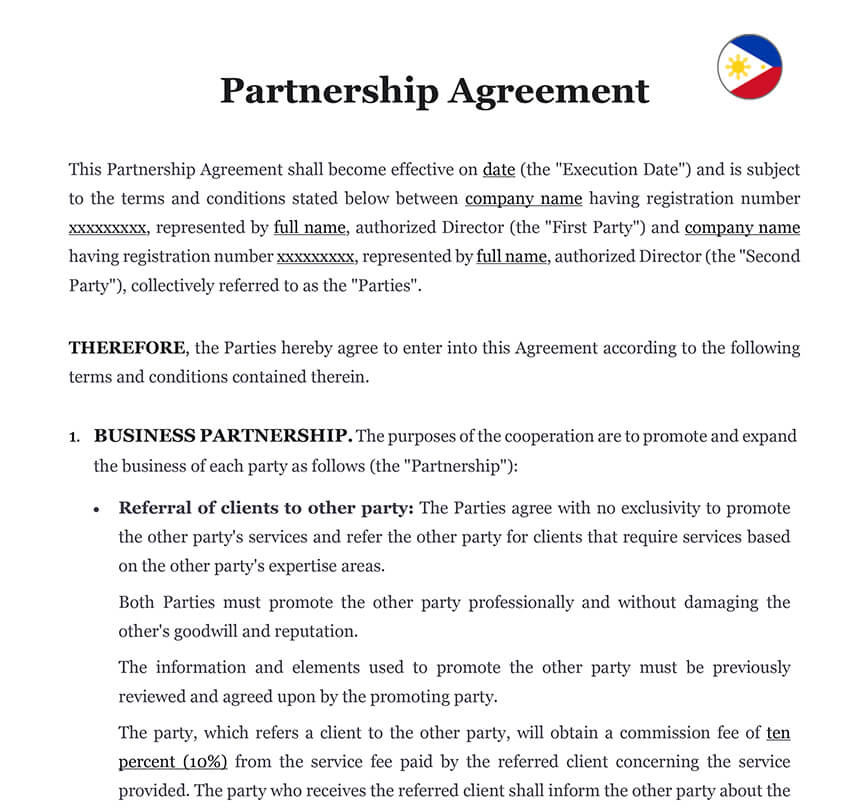Ready to use legal template
Drafted by experienced lawyers
Compliant with Filipino law
Ready to use legal template
Drafted by lawyers
Compliant with Filipino law
Home › Business contracts › Partnership agreement
Learn more about Partnership Agreement in Philippines
In the Philippines, registering a Partnership Agreement is required. It might be simple or difficult, depending on your legal framework. Partnerships and corporations, unlike sole proprietorships, must be registered with the Securities and Exchange Commission (SEC). A partnership is one of the most popular types of company in the Philippines. This is because you have someone with whom to collaborate (a partner), rather than managing everything on your own. It has two or more partners and much of capacity for capital and expansion. If you are debating whether to expand your firm, you should consider this sort of corporate entity. If you need to, do not hesitate to consult our other agreement templates, such as Consulting Agreement or Shareholders Agreement.
Table of contents
What is a Partnership Agreement?
A partnership is a legally binding arrangement between two or more businesses. When two firms from Philippines or elsewhere join forces to fulfill their mutual interests in a certain fashion, you should enter into a partnership agreement with them. Depending on the nature of your partnership and the nature of your company’s operation, establishing a compelling and exciting Partnership Agreement may necessitate the aid of a lawyer who provides you with the option to download your Partnership Agreement. Create an agreement to manage and operate the firm together in order to profit from a business partnership. Each partner shares in the partnership’s earnings and losses.
What laws apply to business partners?
According to the Philippine Civil Code, a partnership is defined as follows:
According to Art. 1767, the partnership contract binds two or more people to contribute money, property, or industry to a common fund with the goal of distributing the gains among themselves.
A partnership can also be formed by two or more people to practice a profession.
In many aspects, a partnership differs from a corporation. First, the partnership has no temporal restriction because its existence is determined by the parties’ agreement. A company, on the other hand, can exist for a maximum of fifty (50) years. Second, in terms of the onset of juridical personality, a partnership becomes a juridical person from the start of the contract, but a corporation does not become a juridical person until it is registered with the Securities and Exchange Commission (SEC).
Third, although a partner may transfer his interest in a partnership to another, the transferee does not automatically become a partner unless all the other partners give their consent. However, in corporations, when the shares of stock are transferred to another, the transferee becomes a stockholder of the corporation. Fourth, as to liability to third persons, partners may be held liable with their private and personal property while in corporations, the stockholders are generally liable only to the extent of their subscribed capital stock. Lastly, a partnership may be dissolved due to the insolvency, civil interdiction, death, insanity or retirement of any of the partners while such grounds do not dissolve a corporation.
Why use a Partnership Contract?
A Partnership Agreement is very easy to draft and is appropriate for collaborations with two to 10 people. The pact, though, might also be utilized for larger cooperation.
You may be able to recruit new staff if you give an incentive to become a partner. The ownership shares of partnership assets, revenue, and costs do not have to be equal. Your share ratio might be 50:50, 60:40, 70:30, or any combination of the above.
A Partnership Agreement benefits from the complimentary talents of two or more persons. Your company now has a greater pool of knowledge, skills, and relationships. This contract can be utilized if one or more of the partners is “sleeping” or “silent,” that is, donating finances, experience, or assets but not participating in the firm’s day-to-day activities.
While most Partnership Agreements involve human partners, this agreement can also be used when one or more of the parties is a company or a non-profit organization. Your ‘business’ as partners might be a single specialized endeavor, such as a technology development project, and it does not have to be commercial in nature.
What are the steps to register a partnership business?
Step 1. File a registration statement with the Securities and Exchange Commission (SEC)
The first step is to register your company with the SEC. In the Philippines, they are in charge of regulating partnerships and companies. You must input the following information here:
| ➤ Name Verification Slip |
| ➤ Partnership Articles |
| ➤ Joint Affidavit (Not required if already stated in Articles of Partnership) |
| ➤ Clearance Endorsement (From other government agencies) |
| ➤ Form 105 of the FIA (If you have a foreigner partner) |




